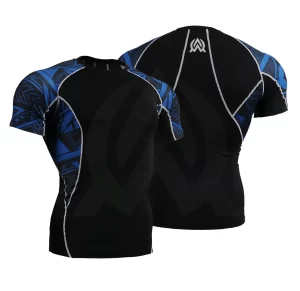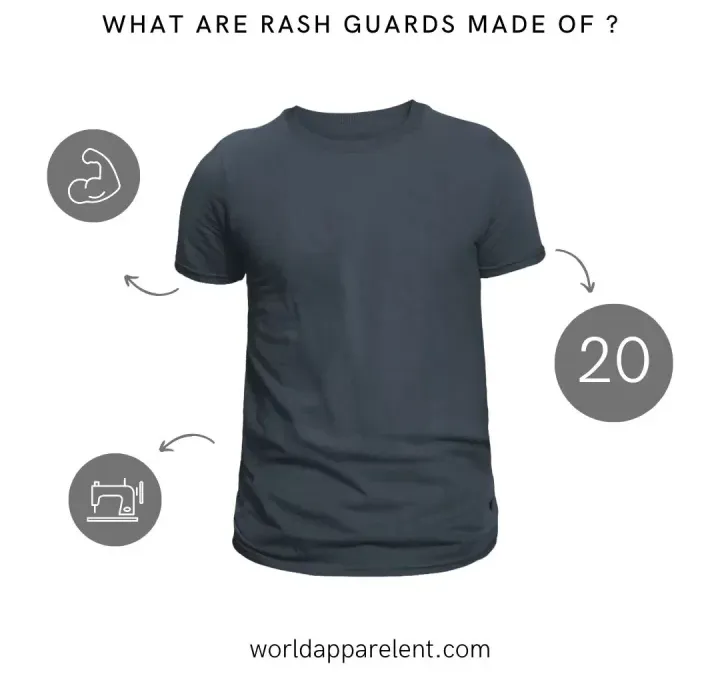Rash guards made are typically made from a blend of synthetic fabrics that provide a balance of stretch, durability, and quick-drying properties.
What is Rash Guard ?
A rash guard is a type of athletic shirt that is typically made from a spandex, nylon, or polyester blend material. It is designed to be worn in or around water and provides protection against irritation and chafing that can occur when participating in water sports, such as surfing, paddleboarding, or swimming.Rash guards are often form-fitting and can have long or short sleeves, depending on the level of coverage and protection needed.
They may also have a UPF rating, which stands for Ultraviolet Protection Factor, indicating the level of protection they offer against the sun’s harmful UV rays.Rash guards can come in a variety of colors and patterns, and some may also have additional features such as zippers, pockets, or thumbholes. They are a popular choice for many water sports enthusiasts as they offer both protection and style.

What Are Rash Guards Made Of ?
- Nylon
Nylon is a synthetic polymer that is commonly used in the production of rash guards. It is a lightweight and durable material that can withstand the harsh conditions of saltwater, chlorine, and sunlight exposure. Nylon also has excellent moisture-wicking properties that help keep the skin dry and comfortable. In addition, it is resistant to abrasions and tears, making it a popular choice for surfers, swimmers, and other water sports enthusiasts.
- Spandex
Spandex, also known as elastane, is a synthetic fiber that is commonly blended with nylon to create rash guards. Spandex provides excellent stretch and recovery properties, allowing the garment to move with the body and retain its shape after multiple wears. This material is also resistant to fading and degradation from exposure to sunlight, chlorine, and saltwater.
- Polyester
Polyester is a synthetic fiber that is commonly used in the production of rash guards. It is a durable and lightweight material that is resistant to stretching, shrinking, and wrinkling. Polyester also has excellent moisture-wicking properties that help keep the skin dry and comfortable, making it ideal for water sports. In addition, it is resistant to fading and degradation from exposure to sunlight, chlorine, and saltwater.
- Lycra
Lycra, also known as spandex or elastane, is a synthetic fiber that is commonly blended with nylon and polyester to create rash guards. It is a stretchy and lightweight material that provides excellent support and compression. Lycra also has moisture-wicking properties that help keep the skin dry and comfortable, making it ideal for water sports. Additionally, it is resistant to fading and degradation from exposure to sunlight, chlorine, and saltwater.
Benefits Of Wearing Rash Guard
Rash guards, including the “bullets” style, can provide several benefits to individuals who wear them, especially during water activities. Some of these benefits include:
- Protection from the Sun: Rash guards are designed to provide UPF (Ultraviolet Protection Factor) to protect the skin from harmful UV rays. This helps to reduce the risk of sunburn and long-term damage to the skin.
- Reduced Irritation: The tight-fitting nature of rash guards can help to reduce irritation and chafing caused by friction between the skin and clothing or equipment.
- Increased Comfort: Rash guards are made of lightweight, quick-drying material that is comfortable to wear and won’t weigh you down when wet.
- Added Warmth: Rash guards can provide a layer of warmth, which can be especially beneficial when engaging in water activities in cooler temperatures.
- Improved Performance: Rash guards can improve performance by reducing drag in the water and allowing for greater range of motion during physical activities.
- Versatility: Rash guards are versatile and can be used for various water activities, such as surfing, swimming, and paddleboarding.
Types Of Rash Guards
There are several types of rash guards available in the market, including:
- Long-sleeved rash guards – These are the most common type of rash guard, providing full coverage of the arms and torso.
- Short-sleeved rash guards – These are similar to long-sleeved rash guards, but with shorter sleeves that provide less coverage.
- Sleeveless rash guards – These are ideal for warmer climates and for activities that require maximum mobility of the arms, such as paddleboarding or kayaking.
- Compression rash guards – These are made with a tighter, stretchy fabric that fits snugly against the skin, providing added support and reducing muscle fatigue.
- Thermal rash guards – These are made with thicker fabric that provides insulation, making them ideal for colder water temperatures.
- Loose-fit rash guards – These are designed to be worn over a swimsuit or wetsuit, providing additional sun protection and coverage.
- Rash guard tops with built-in bras – These are designed for women and provide extra support and coverage for the bust area.
- Rash guard dresses – These are a stylish option for women, providing full coverage and sun protection while still allowing for freedom of movement.
Tip: It’s also important to look for a fabric that provides UPF (Ultraviolet Protection Factor) protection, which helps to block harmful UV rays from the sun. Most rash guards on the market provide UPF 50+ protection, which is the highest level of protection available.
Conclusion
rash guards are typically made from a combination of synthetic fabrics, such as nylon, spandex, polyester, and Lycra, to provide the desired properties of stretch, durability, moisture-wicking, and resistance to fading and degradation from exposure to sunlight, chlorine, and saltwater. These materials are carefully chosen to ensure that the garment can withstand the harsh conditions of water sports and provide maximum protection and comfort to the wearer.

